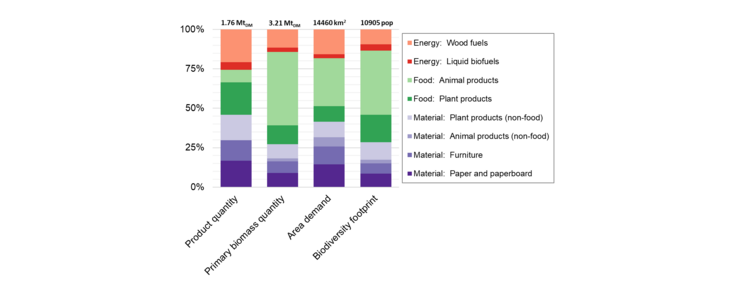Summary
An increasing share of global resources is used for supplying growing urban agglomerations, causing sizable global environmental footprints of urban consumption. In this project we investigated the global biodiversity footprint (BDF) of urban biomass consumption i.e., the impact of biomass-based food, energy and material consumption in the city of Vienna (Austria) on the global loss of vertebrate species. We defined the biodiversity footprint as the number of vertebrate species populations disappearing locally at the landscape level (~80km2). We developed a novel method to trace consumption of final biomass-based products back to primary biomass production and land use and to link it to vertebrate species loss in the source regions. Our approach allows to produce biodiversity footprint maps in high spatial and product resolution, and to disentangle the influence of biomass conversion efficiency, land use intensity and native species richness in the source regions on the BDF of each specific product and associated primary biomass.

Figure 1: Relative composition of final product and embodied primary biomass quantity consumed in Vienna, and associated area demand and biodiversity footprints. Above the bars, the absolute total values are given. Source: Semenchuck et al. 2023
The Figure shows that in 2010, the city of Vienna’s 1.7 million inhabitants used 1.76 million tons dry matter (MtDM) of biomass as food, energy carrier and various materials. To produce these commodities, 3.21 MtDM primary biomass were extracted from terrestrial ecosystems worldwide, which implies that roughly 1.45 MtDM primary biomass were lost during conversion processes or as waste flows. To extract the total of 3.21 MtDM primary biomass, about 14500 km² of land was used in various ways in Austria, Europe and the global hinterland, which is roughly 35 times the area of Vienna itself. Most of the BDF occurs nationally within Austria and in neighbouring countries, and roughly 20% outside of Europe, mainly in tropical regions in South America, Sub-Saharan Africa and Asia. The product specific BDF varies greatly, with ruminant meat having the highest impact per ton DM, while among plant products stimulants (e.g. coffee), which are mainly sourced from tropical regions, have the highest impact per ton. In the scenario analysis we focused on food system changes, since the food system is responsible for the largest part of the species loss (58% in 2010). We find that shifts towards vegetarian or vegan diets can reduce Vienna’s biodiversity impact by up to 37 and 43%, respectively. Reduction of caloric intake to a recommended level and reduction of avoidable food loss can further reduce the BDF by up to 14%. A relocation of production to domestic sources can reduce total biodiversity losses by 4.5 to 21.4% due to often higher yields and lower native species richness in Austria compared to current source countries. We conclude that dietary change is a key leverage point for reducing the urban BDF to which city governments can directly contribute via public procurement. Bio-economy strategies that aim at expanding the use of biomass, in contrast, run danger to increase the BDF and require appropriate monitoring.
Literatur:
Semenchuk, P., Kalt, G., Kaufmann, L., Kastner, T., Matej, S., Bidoglio, G., Erb, K.-H., Essl, F., Haberl, H., Dullinger, S., & F. Krausmann, 2023. The global biodiversity footprint of urban consumption: A spatially explicit assessment for the city of Vienna. Science of the Total Environment, 861, 160576, https://doi.org/10.1016/j.scitotenv.2022.160576
